Stop Creating New Content:
Turn Old Content into SEO Powerhouses
Introduction
The Value of Repurposing Content
In today’s digital landscape, creating compelling content is essential for engaging audiences and driving organic traffic. However, continually producing new material can be time-consuming and resource-intensive. This is where content repurposing comes into play.
Leveraging Repurposed Content for SEO Benefits
Repurposing content involves taking existing material and adapting it into different formats or platforms to reach new audiences and extend its lifespan. When done strategically, repurposing content can not only save time and resources but also yield significant SEO gains.

Understanding Repurposing Content
Defining Content Repurposing
Content repurposing refers to the process of taking existing content and reimagining it in various formats or for different platforms. It allows you to extend the reach of your content and extract maximum value from your existing assets.
The Role of SEO in Content Repurposing Strategies
SEO plays a crucial role in content repurposing strategies by ensuring that repurposed content remains discoverable and relevant to target audiences. By incorporating SEO best practices into repurposed content, you can enhance its visibility and effectiveness.
Identifying Evergreen Content
Recognizing Evergreen Content Assets
Evergreen content is material that remains relevant and valuable to audiences over an extended period. Identifying evergreen content assets is the first step in developing a successful content repurposing strategy.
Analyzing Performance Metrics for Content Selection
Performance metrics such as traffic, engagement, and conversions can help you identify evergreen content that resonates with your audience. By analyzing these metrics, you can prioritize content for repurposing based on its effectiveness.
Adapting Content for Different Formats
Transforming Written Content into Visual Assets
Written content can be repurposed into visual assets such as infographics, videos, or slide decks. Visual content tends to be more shareable and engaging, making it ideal for reaching new audiences and enhancing SEO.
Converting Long-Form Content into Bite-Sized Pieces
Long-form content can be repurposed into bite-sized pieces such as blog posts, social media updates, or email newsletters. Breaking down lengthy material into digestible chunks makes it more accessible to audiences and increases its SEO potential.
Optimizing Repurposed Content for SEO
Incorporating Relevant Keywords
When repurposing content, it’s essential to incorporate relevant keywords to ensure that it remains optimized for search engines. Conduct keyword research to identify relevant terms and phrases to include in repurposed content.
Updating and Refreshing Content for Relevance
Regularly updating and refreshing repurposed content is essential for maintaining its relevance and effectiveness. Keep abreast of industry trends and developments to ensure that repurposed content remains current and valuable to audiences.
Distributing Repurposed Content Across Platforms
Utilizing Social Media Channels
Social media platforms provide valuable opportunities for distributing repurposed content to a wider audience. Share repurposed content across your social media channels to increase visibility and engagement.
Syndicating Content on Industry-Relevant Websites
Syndicating repurposed content on industry-relevant websites can help you reach new audiences and establish your authority in your niche. Seek out opportunities to contribute guest posts or articles to reputable websites within your industry.
Measuring the Impact of Repurposed Content on SEO
Tracking Changes in Search Engine Rankings
Monitor changes in search engine rankings to gauge the impact of repurposed content on SEO performance. Improvements in rankings for targeted keywords indicate that repurposed content is resonating with audiences and driving organic traffic.
Monitoring Traffic and Engagement Metrics
Track traffic and engagement metrics such as page views, time on page, and social shares to assess the effectiveness of repurposed content. Positive trends in these metrics indicate that repurposed content is effectively engaging audiences and generating interest.
Ensuring Consistency and Quality
Maintaining Brand Voice and Messaging
Consistency in brand voice and messaging is crucial for maintaining brand identity and credibility across repurposed content. Ensure that repurposed content aligns with your brand’s tone, style, and values to reinforce brand recognition and trust.
Upholding Standards Across Repurposed Content
Maintaining high standards of quality across repurposed content is essential for preserving its effectiveness and impact. Adhere to best practices for content creation, including thorough research, clear writing, and attention to detail.
Balancing Original and Repurposed Content
Finding the Right Mix for Your Content Strategy
Balancing original and repurposed content is key to a successful content strategy. While repurposed content can save time and resources, it’s essential to continue creating original material to keep audiences engaged and attract new followers.
Avoiding Over-Repurposing and Dilution of Message
Over-repurposing content can lead to dilution of your brand message and audience fatigue. Be strategic in your approach to content repurposing, focusing on quality over quantity, and ensuring that each piece serves a distinct purpose.
Innovative Strategies for Content Repurposing
Experimenting with Interactive Content Formats
Explore innovative content formats such as quizzes, polls, or interactive tools to repurpose existing material in engaging and interactive ways. Interactive content encourages user participation and can help increase dwell time and social sharing.
Leveraging User-Generated Content for Repurposing
User-generated content, such as customer testimonials or reviews, can be repurposed to create compelling social proof and drive engagement. Incorporate user-generated content into your repurposing strategy to showcase real-life experiences and build trust with your audience.
Engaging with Your Audience
Encouraging User Interaction and Feedback
Encourage user interaction and feedback to foster a sense of community and engagement around your content. Ask questions, respond to comments, and solicit suggestions for repurposing ideas to involve your audience in the content creation process.
Soliciting Suggestions for Repurposing Ideas
Invite your audience to contribute ideas for repurposing existing content. By involving them in the creative process, you can gain valuable insights and ensure that repurposed content resonates with their interests and preferences.
Addressing Common Challenges
Overcoming Resistance to Change
Resistance to change can be a common challenge when implementing content repurposing strategies. Educate stakeholders about the benefits of repurposing content, such as increased reach and engagement, to overcome resistance and garner support for your efforts.
Managing Time and Resources Effectively
Effective time and resource management are essential for successful content repurposing. Develop streamlined processes and workflows to maximize efficiency and ensure that repurposed content meets quality standards and deadlines.
Conclusion
Maximizing SEO Impact Through Content Repurposing
In conclusion, repurposing content offers significant opportunities for maximizing SEO impact and extending the lifespan of your content investments. By strategically repurposing existing material into different formats and platforms, you can reach new audiences, enhance visibility in search results, and drive organic traffic to your website.
Unlocking the Full Potential of Your Content Library
Unlock the full potential of your content library by embracing content repurposing as a core component of your content strategy. By consistently repurposing and optimizing existing material, you can amplify your message, engage your audience, and achieve your SEO goals more effectively than ever before.
FAQ`s
How does repurposing content benefit SEO?
Repurposing content benefits SEO by extending its reach, increasing visibility, and attracting new audiences through different formats and platforms.
Is there a limit to how many times I can repurpose content?
While there’s no strict limit, it’s essential to avoid over-repurposing content to prevent dilution of your brand message and audience fatigue.
Can I repurpose content that has already been published?
Yes, you can repurpose content that has already been published by adapting it into different formats or for different platforms to reach new audiences.
How can I measure the effectiveness of repurposed content on SEO?
You can measure the effectiveness of repurposed content on SEO by tracking changes in search engine rankings, monitoring traffic and engagement metrics, and analyzing audience feedback and interactions.
What are some creative ways to repurpose content for SEO gains?
Some creative ways to repurpose content for SEO gains include transforming written content into visual assets, converting long-form content into bite-sized pieces, and experimenting with interactive content formats to engage audiences and drive organic traffic.




